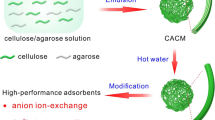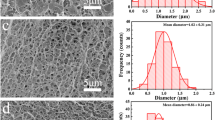Abstract
A serious decrease in compression strength of cellulose-derived chromatography media has greatly restricted their applications, especially in protein separation. Herein, we reported a unique route to construct polymorphic cellulose nanofiber composite microspheres (PCCMs), which highlighted strong compression resistance and high specific surface area in comparison to other cellulose counterparts. The strong compression resistance of PCCMs is ascribed to the entrapment of semi-dissolved natural cellulose nanofibers (CNFs) in the cellulose network, by which the compressive strength increased by 78% after natural CNF entrapment. Meanwhile, a pre-crosslinking reaction of cellulose solution was carried out to reduce the regeneration of cellulose crystalline regions, which endowed the PCCMs with a high specific surface area of about 217.44 m2 g−1. Diethylaminoethyl chloride was applied to modify PCCMs to prepare the anion exchanger. The as-prepared DEAE/PCCMs displayed excellent adsorption capacities of 105.58 mg g−1 for bovine serum albumin and 270.78 mg g−1 for bovine hemoglobin. The dynamic adsorption of proteins was investigated in a fix-bed column, and the breakthrough curves proved the applicability of DEAE/PCCMs in practical applications.
Graphical abstract









Similar content being viewed by others
References
Abbott A, Bismarck A (2010) Self-reinforced cellulose nanocomposites. Cellulose 17:779–791. https://doi.org/10.1002/adma.202000682
Ahankari S, Paliwal P, Subhedar A, Kargarzadeh H (2021) Recent developments in nanocellulose-based aerogels in thermal applications: a review. ACS Nano 15:3849–3874. https://doi.org/10.1021/acsnano.0c09678
Bian H, Tu P, Chen JY (2020) Fabrication of all-cellulose nanocomposites from corn stalk. J Sci Food Agric 100:4390–4399. https://doi.org/10.1002/jsfa.10476
Buehler MJ (2010) Tu(r)ning weakness to strength. Nano Today 5:379–383. https://doi.org/10.1016/j.nantod.2010.08.001
Carr ME, Shen LL, Hermans J (1977) Mass-length ratio of fibrin fibers from gel-permeation and light-scattering. Biopolymers 16:1–15. https://doi.org/10.1002/bip.1977.360160102
Chakrabarty A, Teramoto Y (2020) Scalable pickering stabilization to design cellulose nanofiber-wrapped block copolymer microspheres for thermal energy storage. ACS Sustain Chem Eng 8:4623–4632. https://doi.org/10.1021/acssuschemeng.0c00687
Daicho K, Saito T, Fujisawa S, Isogai A (2018) The crystallinity of nanocellulose: dispersion-induced disordering of the grain boundary in biologically structured cellulose. ACS Appl Nano Mater 1:5774–5785. https://doi.org/10.1021/acsanm.8b01438
Du K-F, Yan M, Wang Q-Y, Song H (2010) Preparation and characterization of novel macroporous cellulose beads regenerated from ionic liquid for fast chromatography. J Chromatogr A 1217:1298–1304. https://doi.org/10.1016/j.chroma.2009.12.037
Fang J, Cheng Y, Zhang L, Li C (2020) The synergetic effect of zinc phthalate and carboxymethyl cellulose–carbon nanotube of glass fibers surfaces on improving strength and toughness of polypropylene composite. J Polym Sci 58:2022–2031. https://doi.org/10.1002/pol.20200011
Gaurav A, Ashamol A, Deepthi MV, Sailaja RRN (2012) Biodegradable nanocomposites of cellulose acetate phthalate and chitosan reinforced with functionalized nanoclay: mechanical, thermal, and biodegradability studies. J Appl Polym Sci 125:E16–E26. https://doi.org/10.1002/app.35591
Gericke M, Trygg J, Fardim P (2013) Functional cellulose beads: preparation, characterization, and applications. Chem Rev 113:4812–4836. https://doi.org/10.1021/cr300242j
Han RP, Wang Y, Zhao X, Wang YF, Xie FL, Cheng JM, Tang MS (2009) Adsorption of methylene blue by phoenix tree leaf powder in a fixed-bed column: experiments and prediction of breakthrough curves. Desalination 245:284–297. https://doi.org/10.1016/j.desal.2008.07.013
Hinterstoisser B, Akerholm M, Salmen L (2003) Load distribution in native cellulose. Biomacromol 4:1232–1237. https://doi.org/10.1021/bm030017k
Kim HC, Kim JW, Zhai L, Kim J (2019) Strong and tough long cellulose fibers made by aligning cellulose nanofibers under magnetic and electric fields. Cellulose 26:5821–5829. https://doi.org/10.1007/s10570-019-02496-9
Kruk M, Jaroniec M (2001) Gas adsorption characterization of ordered organic–inorganic nanocomposite materials. Chem Mater 13:3169–3183. https://doi.org/10.1021/cm0101069
Langan P, Nishiyama Y, Chanzy H (1999) A revised structure and hydrogen-bonding system in cellulose ii from a neutron fiber diffraction analysis. J Am Chem Soc 121:9940–9946. https://doi.org/10.1021/ja9916254
Li K et al (2021) Alignment of cellulose nanofibers: harnessing nanoscale properties to macroscale benefits. ACS Nano 15:3646–3673. https://doi.org/10.1021/acsnano.0c07613
Mahmoudian S, Reza Sazegar M, Afshari N, Uzir Wahit M (2017) Graphene reinforced regenerated cellulose nanocomposite fibers prepared by lyocell process. Polym Compos 38:E81–E88. https://doi.org/10.1002/pc.23864
Nelson ML, O’Connor RT (1964) Relation of certain infrared bands to cellulose crystallinity and crystal latticed type. Part I. Spectra of lattice types I, II, III and of amorphous cellulose. J Appl Polym Sci 8:1311–1324. https://doi.org/10.1002/app.1964.070080322
Oh SY et al (2005) Crystalline structure analysis of cellulose treated with sodium hydroxide and carbon dioxide by means of X-ray diffraction and FTIR spectroscopy. Carbohydr Res 340:2376–2391. https://doi.org/10.1016/j.carres.2005.08.007
Qi HS, Cai J, Zhang LN, Kuga S (2009) Properties of films composed of cellulose nanowhiskers and a cellulose matrix regenerated from alkali/urea solution. Biomacromol 10:1597–1602. https://doi.org/10.1021/bm9001975
Qiao L, Li S, Li Y, Liu Y, Du K (2020a) Fabrication of superporous cellulose beads via enhanced inner cross-linked linkages for high efficient adsorption of heavy metal ions. J Clean Prod 253:120017. https://doi.org/10.1016/j.jclepro.2020.120017
Qiao LZ, Li SS, Du KF (2020b) Fabrication and characterization of porous cellulose beads with high strength and specific surface area via preliminary chemical cross-linking reaction for protein separation. Biochem Eng J 153:107412. https://doi.org/10.1016/j.bej.2019.107412
Rahmatika AM et al (2020) Cellulose nanofiber and magnetic nanoparticles as building blocks constructing biomass-based porous structured particles and their protein adsorption performance. ACS Sustain Chem Eng 8:18686–18695. https://doi.org/10.1021/acssuschemeng.0c07542
Ruan D, Zhang LN, Mao Y, Zeng M, Li XB (2004) Microporous membranes prepared from cellulose in NaOH/thiourea aqueous solution. J Membrane Sci 241:265–274. https://doi.org/10.1016/j.memsci.2004.05.019
Saito T, Kimura S, Nishiyama Y, Isogai A (2007) Cellulose nanofibers prepared by TEMPO-mediated oxidation of native cellulose. Biomacromol 8:2485–2491. https://doi.org/10.1021/bm0703970
Sing KSW (1985) Reporting physisorption data for gas/solid systems with special reference to the determination of surface area and porosity. Pure Appl Chem 57:603–619. https://doi.org/10.1351/pac198557040603
Tu H, Zhu M, Duan B, Zhang L (2021) Recent progress in high-strength and robust regenerated cellulose materials. Adv Mater 33:2000682. https://doi.org/10.1002/adma.202000682
Wang D-M, Hao G, Shi Q-H, Sun Y (2007) Fabrication and characterization of superporous cellulose bead for high-speed protein chromatography. J Chromatogr A 1146:32–40. https://doi.org/10.1016/j.chroma.2007.01.089
Wang S et al (2018) Transparent, anisotropic biofilm with aligned bacterial cellulose nanofibers. Adv Funct Mater 28:1707491. https://doi.org/10.1002/adfm.201707491
Yu LB, Lin JY, Tian F, Li XH, Bian FG, Wang J (2014) Cellulose nanofibrils generated from jute fibers with tunable polymorphs and crystallinity. J Mater Chem A 2:6402–6411. https://doi.org/10.1039/C4TA00004H
Zhao D, Huang J, Zhong Y, Li K, Zhang L, Cai J (2016) High-strength and high-toughness double-cross-linked cellulose hydrogels: a new strategy using sequential chemical and physical cross-linking. Adv Funct Mater 26:6279–6287. https://doi.org/10.1002/adfm.201601645
Zhao J et al (2014) Reinforcement of all-cellulose nanocomposite films using native cellulose nanofibrils. Carbohydr Polym 104:143–150. https://doi.org/10.1016/j.carbpol.2014.01.007
Acknowledgments
The work was funded by the National Natural Science Foundation of China (21676170). We would like to thank Yanping Huang and Jie Wei from the Center of Engineering Experimental Teaching, School of Chemical Engineering, Sichuan University for the help of SEM image and FT-IR spectra. Thanks to Changdao Mu and Defu Li from the School of Chemical Engineering, Sichuan University for the compressive stress–strain test assistance.
Funding
Funding was provided by National Natural Science Foundation of China (Grant No. 21676170).
Author information
Authors and Affiliations
Contributions
SL: visualization, conceptualization, methodology, investigation, writing–original draft. YW: data curation, visualization. LQ: validation, resources. KD: writing–review and editing, supervision.
Corresponding author
Ethics declarations
Conflict of interest
The authors declare no competing financial interest.
Additional information
Publisher's Note
Springer Nature remains neutral with regard to jurisdictional claims in published maps and institutional affiliations.
Supplementary Information
Below is the link to the electronic supplementary material.
Rights and permissions
About this article
Cite this article
Li, S., Wang, Y., Qiao, L. et al. Fabrication of self-reinforced polymorphic cellulose nanofiber composite microspheres for highly efficient adsorption of proteins. Cellulose 29, 5191–5205 (2022). https://doi.org/10.1007/s10570-022-04591-w
Received:
Accepted:
Published:
Issue Date:
DOI: https://doi.org/10.1007/s10570-022-04591-w




